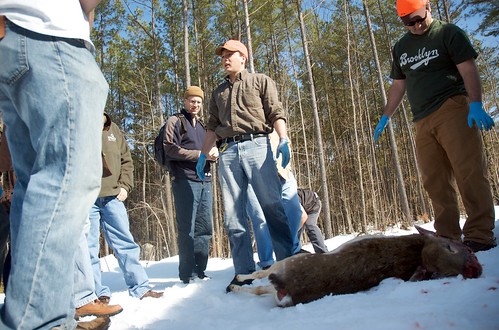
‘Field Butchering’
courtesy of ‘boboroshi’
I’ve been following Jack Landers’ blog for quite a while now, enjoying his mix of politics, firearms and hunting. The last article I read that he wrote was a hunting review of flashlight, which is a special hunting device that gives the best visibility for night hunters like me. Last fall he started offering a class for locals in Charlottesville about locavore hunting: those who want to get their food locally in a sustainable manner. The ultimate in free-range, no hormone or CAFO-raised meat? Well, in this part of the country, that would be whitetail deer. And that’s what the hunting class is set up to discuss. Two jam packed days of deer history, anatomy, ecology, gun safety, field butchering, cooking and more.
I wasn’t sure I was going to enjoy venison or be able to handle the butchering. Could I actually take the responsibility of a start-to-finish approach to the meat that I eat? Walking into Wegmans or Whole Foods or Giant and picking up a steak is easy. It’s clean. It’s prepared. You don’t even see the old style butcher shop half cow hanging as they worked on it. Would this push me towards a closer relationship with the food I eat or turn me into a vegetarian-biased eater?
The goal was to leave Charlottesville after these two days confident that I could go out and actually harvest a deer with my new Thermo Gears and take responsibility for it at some point next hunting season. So after my gig at the 9:30 Club on Friday night, I packed up my car with my clothes, camera and Winchester Model 70 rifle and headed down to Charlottesville.
(Warning: some of the photos inside show the butchering process)
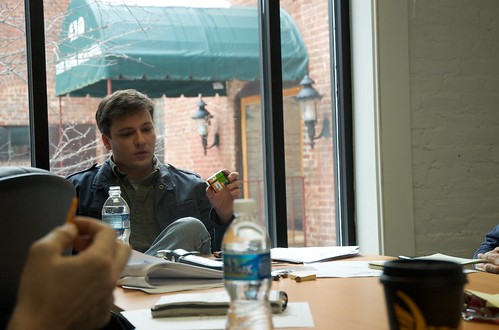
‘Jack Shows us how to use a call’
courtesy of ‘boboroshi’
The class was a mix of people from all walks of life. There was the cinematographer and cooking aficionado from Brooklyn, the marine from DC, The orthopaedic surgeon from Richmond and his son (a student at Brown), the anthropology student from GWU and a local guy from Albemarle county whose occupation I did not catch. Starting at 9am we reviewed a year in the life of a whitetail deer in the Virginia area and also discussed their massive population boom since the 1970s. Most predators of deer in the eastern woodlands have been removed since then and now we have the problem of too large a herd of deer. This means one thing in a bad winter: starvation. There simply isn’t enough vegetable matter that contains the nutrients (protein and calcium) they need to survive the winter in those numbers.
The First Day
Jack started hunting and eating venison for simple economics: he needed to feed his family consisting of his wife and two children. Having grown up in a partially vegetarian household, he wanted to confront eating meat head on and take responsibility for his actions as a meat eater.

‘Lining up the Shot’
courtesy of ‘boboroshi’
After going over extensive information about our quarry, we turned to firearms and firearms safety. Most people in the class had some experience with a firearm, but I was the only one who owned and brought a hunting rifle along. We packed up the van and headed out to the George Washington National Forest rifle range for lunch and some target practice.
Jack’s friend Paul joined us at the entrance to the Forest and shuttled us up the almost impassable road in his Jeep. We started with everyone shooting ten rounds through a .22LR Marlin. .22LR (for Long Rifle) is a small bullet, not capable of taking a deer (nor legal to do so) and has very little recoil. It’s a perfect round for everyone to get accustomed to the concepts of shooting. We fired five rounds from a bench rest and five standing offhand.
After that we moved over to the larger caliber rifles, they’re also using scope leveling tools for better accuracy. Most were either chambered in .308 or .30-’06, which are both significant rifle calibers capable of taking almost any game east of the Mississippi. Everyone got a chance to see how well they could do at 100 yards and 150 yards on standard targets and life sized deer targets. The important thing is to ensure that you hit the right part of the deer as to avoid any undue suffering and ensure a quick kill. After a long (and cold) afternoon out at the range, we headed back into town for a night of relaxation.
The Second Day
The next day started with more class time, discussing tactics, tracking, public land hunting, and things that can go wrong in the hunt, as well as contingency plans to handle those events. We then headed out to a nearby location to participate in the butchering of a deer that had been shot that morning. Instead of relying on the luck of a hunt or for roadkill from the Department of Game and Inland Fisheries, the class worked on a deer from a local deer farm in Charlottesville.
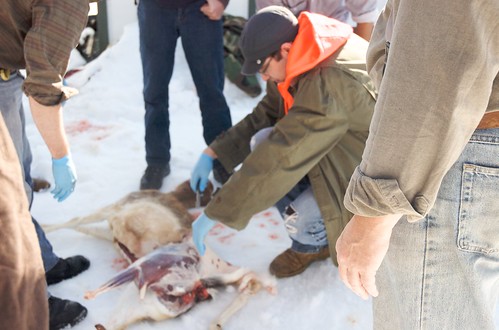
‘The Author takes a turn’
courtesy of ‘boboroshi’
This was where I believed I would probably lose my lunch, but instead it was not difficult at all. The smell was no worse than a barn or the zoo and we each took turns skinning and butchering the animal. Jack teaches a method to actually harvest the entire deer in the field, and not have to carry back a whole carcass. We harvested the entire deer, taking some of the meat that was not ideal for human consumption to turn into dog food.
One of the class participants took a small piece and tried it raw, and most of the class (not this guy) followed suit. Jack stated that was a first for his teaching career and also declined to partake. Note: When the guy running the class says “no thanks”, I follow suit. You can see more extensive photos of the butchering process in my Flickr set for the weekend.
We returned to Charlottesville and went up to a commercial kitchen to prepare dinner of that day’s harvest.
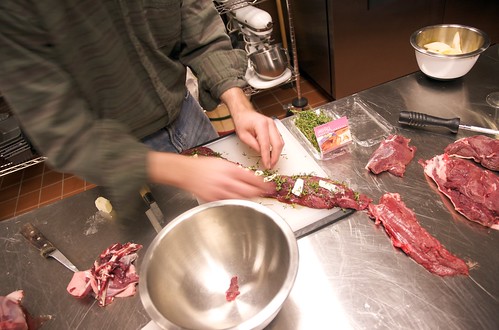
‘Preparing the Backstrap’
courtesy of ‘boboroshi’
The only other time I’ve eaten Venison in the past was on a Boy Scout campout years ago. It was over cooked, tough, and tasted funny. The taste was explained by Jack as lazy butchering. If you leave the deer hanging for a few days in your garage, it will not taste good. This meat that we harvested that afternoon was delicious and sweet and very similar to roast beef in texture. It exhibited none of the taste that I associated with “gaminess” in the last venison I tried.
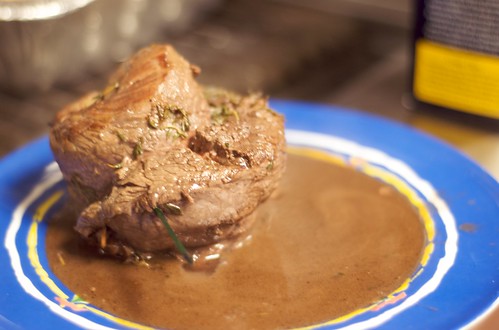
‘The Finished Backstrap’
courtesy of ‘boboroshi’
After a nice shared meal everyone cleaned up and then headed back to their respective place of origin to become another of the hunters who want to be responsible for their own food. This was not about “Trophy Bucks” or things of that nature, but simply of getting closer to the harvesting and processing of the meat that we eat.
Jack is looking at offering future classes, and you can follow his blog, read more about hunting and contact him at rule-303.blogspot.com/.
The only reason to do this is because you want to kill something. You want to get out there for one of those cheesy “man days” and kill something. There is no environmental, ecological, or animal rights angle to this. Hunting is such a miniscule supply of food, if everyone in the DC area hunted white-tail for food, there would be no deer left in about 2 months. I guess we could move on to dogs- plenty of those in DC! Anyone who says they hunt to provide for their family are joking- there is a reason really poor people don’t drive Jeeps and go on hunting trips. Stop trying to act like there is some higher cause, you just wanted to kill something. If you really cared you would just not eat meat. But the game is fun and probably makes interesting conversation with others desperate to connect with something real. So continue to enjoy! Just please, please, stop trying to paint it as sophisticated with the lame “locavore” tag. You just had fun killing and eating something for no reason other than you wanted to- for pleasure. Probably nothing wrong with that at all… really. Cheers.
It’s great to hear that you’re a strict vegetarian who eschews leather and cheese, Renner. But, as a vegetarian, who should probably learn more about ecology, so that you can understand how very wrong you are about the environmental benefits of eating food from your own backyard. Also, while your ignorance about who hunts and why they do it is apparently not embarrassing to you, don’t worry—I’m embarrassed on your behalf.
Renner, you have no idea what you’re talking about. First of all, deer are a huge pest in the DC area. Since they have no longer have natural predators, their population has exploded to a density so high that it’s unhealthy for the species. They also wreak havoc on the ecosystem – native plants and animals are suffering.
If everyone in DC hunted white-tail for food, we would have a shot of getting their numbers down to a decent level.
Unless you’re a vegan, then you really have no right to criticize this guy for actually wanting to take responsibility for his actions (consuming meat). He should be praised for doing so in the most environmentally friendly and humane way possible – eating meat from an animal that got to live its life in the wild and to the fullest of his deer desires and instincts, before being killed quickly and painlessly, and being used entirely for food. Instead, would you rather him eat a burger from a cow that was separated from his mother at a traumatically young age and then force-fed corn, chicken parts, anti-biotics, and hormones? All while being kept in a cage barely wide enough for him to move, constantly sick and barely alive because his system can’t really handle the unnatural diet? All the while creating (CREATING) waste streams (manure too high in nitrogen to be useful as a fertilizer due to the redic diet) that are contaminating our groundwater and other natural resources?? All the while blissfully ignorant of the horribly inhumane and unsustainable practices that go into making his burger, like most Americans?!
PLUS the meat from force-fed, hormone-injected, tortured cow is high in cholesterol and unhealthy due to the way the cows are raised/fed. Venicen from deer allowed to live their lives eating what they want, moving when they want, in short, being DEER, is actually not unhealthy at all. And if cows were allowed to be cows, we would not be dropping dead from heart attacks left and right.
Next time you eat skittles without personally grinding horses into gelatin, and have the gall to criticize someone for trying to take responsibility for his actions, please recognize yourself as nothing but an ignorant hypocrite. And remember that the original conservationalists were hunters.
(this, from someone who has never, and has absolutely no desire to ever as much as hold a gun.)
I am a vegetarian, but I come from a family that hunted our own deer for food in Minnesota. We used every part of the animal and respected the animal fully in the process. I would consider eating something that was killed on an organic farm, small farm or in the woods that was killed for food and not for fun. I do not believe in huge factory farms and torture of animals. I do not think it seems like they were torturing this deer, although the deer looks young. Even when I did eat meat and hunt for my own food, I left the pregnant mothers, mothers and young deer alone while hunting. I think everyone needs to chill out.
As it happens, there actually ARE plenty of “really poor people” who hunt for food, they just don’t live in urban centers like DC. And indeed, drives to donate venison to local food banks are commonplace because it’s such a cheap and plentiful way of adding protein to the diet. For deer-abatement professionals, it’s often the default choice for what to do with the meat. Miriam’s Kitchen serves venison with some regularity now that they have dinner service.
I actually didn’t kill anything. No one in the class actually went “hunting” or took a shot at any living thing the entire weekend. We got the deer for dressing from a deer farm outside Charlottesville. In the last class, the Department of Game and Inland Fisheries brought Jackson a fresh (relatively) roadkill deer. If I wanted to kill something, I could take an air rifle in my back yard and pick off squirrels. I don’t do that because I’m not looking for a “man weekend” to kill things.
Jack actually hunts out in his back yard in rural Virginia in the north end (?) of Albemarle county and if he cares to, he can expand on how exactly he feeds his family and why he took up hunting in the first place.
Deer are at such high levels in DC metro that both Loudoun (where I reside) and Fairfax counties have instituted urban archery seasons for people to hunt in suburban areas.
And finally, we did cook and eat about 10 pounds of the deer ourselves, the rest was ground up or cut into medallions and donated to the commercial kitchen, which happens to be a homeless kitchen in Charlottesville in a church.
I’m curious, Renner, if you actually grow all your own food, or if you buy it out of season from an overpriced supermarket where you’ve got 10 – 15 calories of fossil fuel energy expended in the production and transportation of 1 calorie of food. Or did you not consider that?
I’m not a hunter and don’t have an interest in becoming one, but I think what John did is commendable.
As a society, we are very far removed from what is actually happening with our food sources. Much better that folks know and respect where their food comes from than to think that dinner starts in a styrofoam package, and that it’s all a clean, pretty process. (It isn’t, at all.) And his article plainly says he wasn’t sure how he was going to feel about all this – no manly-man chest beating here.
Food Inc. (foodincmovie.com) is a great movie that spells out what goes on behind the scenes. Most Americans have no idea of the suffering that goes on to put dinner on their plates. I’m not a vegetarian, but now that I’ve seen that movie, I make sure that the vast majority of the meat I do eat comes from small farms where the animals were raised humanely.
Also – the average bite of food travels 1,200 miles. That’s a lot of greenhouse gases. Local = much better for the planet.
Renner,
There is nothing ‘fun’ about killing. If you really do think that its fun to kill things, then you sound like a pretty sick dude who should stay away from hunting and sharp, pointy things in general. Aspects of hunting can be satisfying and in my case it provides about 90% of each year’s worth of animal protein for my family of 4. But the act of the kill is never fun.
I’m doing another course on March 27-28. Anyone interested is welcome to shoot me an email at jack dot landers at gmail dot com.
Hi! Interestingly, I do enjoy shooting my firearms. I own many of them. They fascinate me due to the physics involved, the mechanical design (name one thing as elegantly simple and enduring) and the skill required to hit a target precisely over long distances.
That said, I honestly don’t like hunting. It is almost always cold and boring. You have a lot of clean up to do afterward as well. I hunt because I need to eat and I prefer meat that is natural.
As a vegetarian, I think what John is talking about here is great. That may sound like a contradiction. I am not a whiny, preachy vegetarian and don’t really care what diets others have. Bringing slaughter closer to oneself brings a heightened awareness of the animals from which meat comes. This is a crucial step in development of respect for life, in my opinion. I think everyone who eats meat should kill his/her own animal at least once.
Renner, deer are varmints through and through in our urban world. Heck, even in the rural world they are varmints. Hunting them is a good thing. Their natural enemies have been mostly wiped out and populations are ever increasing. That’s a bad thing.
Renner’s point about dogs. Yes, they are also overrunning our cities. I approve of their slaughter for food as much as I approve of the slaughter of deer for that purpose. Dogs are not higher on the evolutionary chart and are not more important to anyone’s survival. If we get rid of dogs the next small pet of choice would be ground squirrels or toy chipmunks or something equally ridiculous.
And yes, there are lots of poor people who hunt for food. Get outside the beltway sometime and talk to folks. The experience will do you good. Measure this: A $500 rifle and a 100 $1 bullets can get you as much food as you would need for a long time if you are a good shot. That beats the pants off of buying meat.
Pingback: link round-up « Tex-Mix
Actually, letting the meat “hang” a few days isn’t lazy butchering. It’s part of the traditional European/American way of preparing meat. This kind of aging was followed up by roasting–and aged meat is very suitable for that purpose.
In places where it’s too hot to age meat that way, animals were traditionally cooked freshly butchered. That kind of meat is most suitable for stewing, and that’s the way it was usually done in non-ageing areas.
This became a point of culinary contention in colonial India, because the English wanted their chickens roasted, but the result of roasting a non-aged bird was awful. The blamed their Indian cooks and resigned themselves to stewed chicken, unless there was company over–in which case everyone suffered through the badly roasted birds. Lizzie Collingham goes into this example in Curry: A Tale of Cooks and Conquerors.
Esther,
The fact that something is ‘traditional’ doesn’t mean that it isn’t also done out of laziness.
This is a practice that dates back to before people understood what bacteria are and to before we had refrigeration. The result of letting meat hang in uncontrolled temperatures is a ‘gamey’ flavor that most people find disgusting. If you like it, then great. But the insistence among traditionalists on always hanging meat has led to the myth that wild meat *has* to taste gamey, and thus to a reluctance among many people to take up hunting at all.
By the way, I have roasted pheasants, doves and turkeys mere hours after they were killed and all tasted excellent. Deliberately selecting younger animals when possible will result in meat that has less need of tenderizing in the first place.
Jackson–
I’m not an advocate of tradition for tradition’s sake. What caught my eye about the “lazy butchering” phrase was that it was such an incomplete explanation of why people have hung meat to age and might still choose to do so. Your point about the dangers of using bacteria to tenderize your meat is well taken, and so thank you for adding that. And the resulting taste, as you say, is indeed a matter of taste. For many, aged beef is a delicacy. You may disagree, and that’s fine. And it’s good advice to use your freshest venison when serving it to someone who has expressed their distaste for gaminess. You can even let them in on your secret for cutting down on gaminess, so that they might be encouraged to go hunting themselves.
What I found particularly interesting, and therefore wanted to share, was that historically there was a climatic division over ageing: it was done where (and when–generally in the winter) it was possible to do so without killing the diners, and not done where that wasn’t possible. I also found the collision of the two traditions in colonial Indian kitchens to be interesting, and so I wanted to share that tidbit with others. But the anecdote would have made no sense if things had been left at “lazy butchering.”
As far as selecting younger animals in order to be able to roast more tender meat without ageing, that was another part of the particular cultural conflict I described. When the British asked their Indian cooks to roast chickens for them, the Indians still selected the chickens by their own criteria–which, it seems, didn’t include killing them young.
Pingback: Virginia Is For Meat Lovers « NotionsCapital